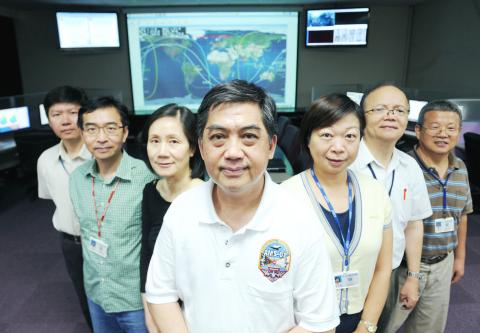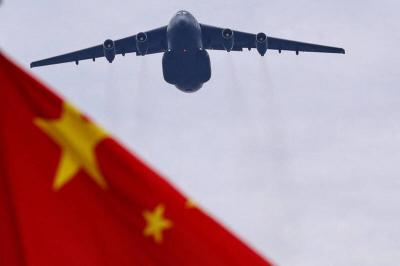A ground control center for an advanced particle physics detector that was sent into space last year to gather data about the origin of the universe will be inaugurated in Taiwan tomorrow, a military researcher said yesterday.
“It will be the world’s second and Asia’s first ground control facility for the space device, known in academic circles as the Alpha Magnetic Spectrometer-02 [AMS-02],” said Jinchi Hao (荊溪暠), a project director at the military-run Chung-shan Institute of Science and Technology (CSIST).
The state-of-the-art detector, which was designed and built by elite scientists from 16 countries including Taiwan, was taken to the International Space Station in May last year by the US space shuttle Endeavour on its final flight. It is designed mainly to detect charged particles in cosmic rays to find anti-matter, dark matter and missing matter in the hope of answering questions about the “big bang” and the formation of the universe, Jinchi said.

Photo: CNA
“To date, the detector has transmitted 18 billion pieces of data back to the project’s headquarters at the European Organization for Nuclear Research in Geneva,” Jinchi said, adding that the data could hold the key to revealing the origin of the universe.
Currently, experts at the Geneva station are working in shifts around the clock, with the US’ NASA Space Center in Houston providing backup support. To reduce the Geneva staff’s workload and allow even more comprehensive monitoring, project leader Samuel Ting (丁肇中) proposed the establishment of a similar ground station in Asia, to be dubbed “Payload Operations Control Center.” Ting is an Academia Sinica researcher and Nobel laureate in physics.
Other countries expressed strong interest in hosting the new facility because it would allow them to play a more important role in the joint project and facilitate bilateral or multilateral technological exchanges, Jinchi said. However, Taiwan was ultimately selected because it has been participating in the project for more than 10 years and has won much acclaim for its contributions in developing the device’s electronics system — which plays a crucial role in the project — he added.
“The establishment of the center is a new milestone in our participation in international space research programs,” Jinchi said.
The new payload control center will be located in the CSIST’s Lungyuan Research Park in Lungtan Township (龍潭), Taoyuan County. Initially, the center will not be able to communicate directly with the International Space Station, Jinchi said.
“But we expect to gain direct access to the space station soon, with NASA’s authorization,” he said.
NASA personnel have said the facility is comparable to the one in Geneva, said Yeh Fen (葉芬), a manager at the park’s innovation incubating center who is responsible for establishing the AMS-02 ground control station. The center has passed various tests by NASA inspectors, including Internet connectivity and information security checks, he said.
The payload control center, about the size of an average classroom, will be staffed by 12 scientists who will monitor the AMS-02’s “health” in real time via computers, Yeh added. Initially, they will work shifts from 6am to 2pm while the Geneva staff will take the remaining shifts. In the long term, the Taiwanese center will expand its capacity to accommodate three work shifts in case of any emergencies at the Geneva center Yeh said.
The AMS-02 project, launched by the US Department of Energy in 1999 in collaboration with 15 other countries, is scheduled to run for 15 years. CSIST officials said technologies used in the AMS-02 construction can be applied to the development of missiles, other weapons systems and unmanned aerial vehicles.
Meanwhile, the institute’s outstanding contribution to the detector’s electronics system has drawn the attention of other participating countries, some of which have initiated proposals for technological collaboration, the officials said. For instance, an Italian research institute is interested in working with the CSIST to develop a solar panel control system, they added.

Beijing could eventually see a full amphibious invasion of Taiwan as the only "prudent" way to bring about unification, the US Department of Defense said in a newly released annual report to Congress. The Pentagon's "Annual Report to Congress: Military and Security Developments Involving the People's Republic of China 2025," was in many ways similar to last year’s report but reorganized the analysis of the options China has to take over Taiwan. Generally, according to the report, Chinese leaders view the People's Liberation Army's (PLA) capabilities for a Taiwan campaign as improving, but they remain uncertain about its readiness to successfully seize

Taiwan is getting a day off on Christmas for the first time in 25 years. The change comes after opposition parties passed a law earlier this year to add or restore five public holidays, including Constitution Day, which falls on today, Dec. 25. The day marks the 1947 adoption of the constitution of the Republic of China, as the government in Taipei is formally known. Back then the Chinese Nationalist Party (KMT) governed China from Nanjing. When the KMT, now an opposition party in Taiwan, passed the legislation on holidays, it said that they would help “commemorate the history of national development.” That

HORROR STORIES: One victim recounted not realizing they had been stabbed and seeing people bleeding, while another recalled breaking down in tears after fleeing A man on Friday died after he tried to fight the knife-wielding suspect who went on a stabbing spree near two of Taipei’s busiest metro stations, Taipei Mayor Chiang Wan-an (蔣萬安) said. The 57-year-old man, identified by his family name, Yu (余), encountered the suspect at Exit M7 of Taipei Main Station and immediately tried to stop him, but was fatally wounded and later died, Chiang said, calling the incident “heartbreaking.” Yu’s family would receive at least NT$5 million (US$158,584) in compensation through the Taipei Rapid Transit Corp’s (TRTC) insurance coverage, he said after convening an emergency security response meeting yesterday morning. National

Taiwan has overtaken South Korea this year in per capita income for the first time in 23 years, IMF data showed. Per capita income is a nation’s GDP divided by the total population, used to compare average wealth levels across countries. Taiwan also beat Japan this year on per capita income, after surpassing it for the first time last year, US magazine Newsweek reported yesterday. Across Asia, Taiwan ranked fourth for per capita income at US$37,827 this year due to sustained economic growth, the report said. In the top three spots were Singapore, Macau and Hong Kong, it said. South